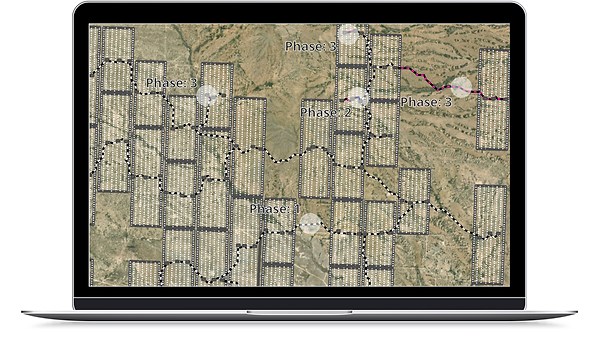
THE PLANNING PROCESS
Methods and options for optimizing Oil & Gas asset placement.

01
STANDARD
OPTIMIZATION

Are you on the hunt for an overview of potential locations for assets? Do you want a full view of the network as it will stand - for now, setting aside the concerns of phases and timelines? The Standard Optimization approach allows for just that by generating features based on the spatial data on hand, including a Digital Elevation Model (DEM), study area, constraints data, existing infrastructure, and the like.
The Standard Optimization approach is ideal for...
Providing an overview of the pipeline gathering system and/or its access roads.
Discovering and customizing those settings and variables that have the greatest impact on efficiency of construction and production.
Displaying multiple options for decision-making prior to determining timelines.
02
BACKCASTING
DEVELOPMENT
Your team has already decided how and where your new assets will be built...but have they come to a decision on when? Establishing a plan for production based on Backcasting Development may be just what you need.
With this approach, the entirety of the network is broken into more manageable bites. Integrated Geomancy looks at the proposed locations of pipeline gathering systems and/or access roads alongside well pad sites to better optimize each phase of development.
We believe Backcasting Development is ideal for...
Planning teams with a clear idea of the final layout of this system - pipeline gathering system and/or available access roads.

Breaking network layouts into more manageable phases based on the number of phases or duration of overall project.
Determining the ideal start/end points and tie-ins for construction necessary to stay within the allowed budget.
03
FORECAST
INSTALLMENTS

Does your company plan to acquire more leases in the coming years? Does your team feel more comfortable casting development based on optimization of each phase rather than the overall pipeline network? Do you just want to be able to see what the next few years could hold?
If that answer is a resounding yes, we support you. The placement of assets can be impacted by any number of factors - Why optimize the entire network when new leases could be acquired or new well pad sites could go online in the near future?
By employing the Forecast Installment approach in your planning process, your team can produce results based on close-range outlooks on production to better plan your pipeline network. Each year's plan is optimized by using existing infrastructure as tie-ins where possible and daisy-chaining new well pad sites to existing sites and pipelines as allowed.
Providing a close-range outlook on the production of your pipeline gathering system and/or its access roads.
The Forecast Installment approach is ideal for...
Developing fields where more wells are planned, requiring more pipelines to be designed and installed at a later time.
Planning teams who are interested in an overview of the system, but are focused on optimizing only those assets that fall in more immediate timelines.

The way in which a developing field is planned will differ from project to project. When considering the area, the presence of assets for tie-ins, the possibility of future development, and many more factors, our teams must choose the approach that best supports these circumstances.
This scenario sounds as if it is a task only a fortune teller would undertake. Thankfully, this is exactly why Integrated Geomancy was built.
CHOOSE YOUR APPROACH
Integrated Geomancy tackles this by offering multiple methods for developing pipeline gathering systems and road alignments in a field. These approaches are unique in their outcome...
without any additional steps from your team.
WHICH IS MOST BENEFICIAL TO 'MY' PLANNING PROCESS?
While we may have an opinion on the matter, the approach you take in your own planning process will depend entirely on the scope of the project, the data with which you are working, and the interests of your organization.
Each approach is valuable in its own right - especially given that they all offer...
Report of all regions within the study area that range from least to most desirable for construction based on elevation and constraints.
Multiple routes for network paths in one clear dataset, offering flexible options for placement.
Breakdown of what data and factors - including geology, anthropogenic, and more - have the greatest impact on the constructability within the area.
Record of data, weights, settings, and allowances used for analysis - great for both reporting and reproducing results!
